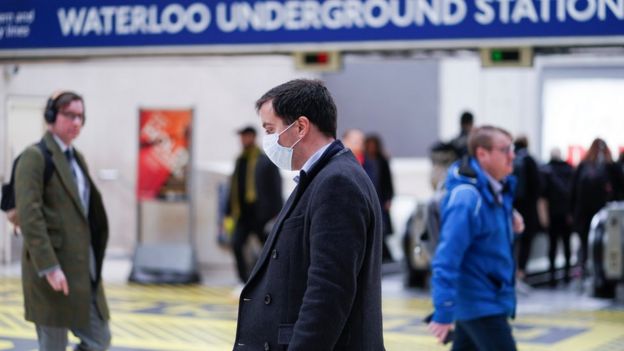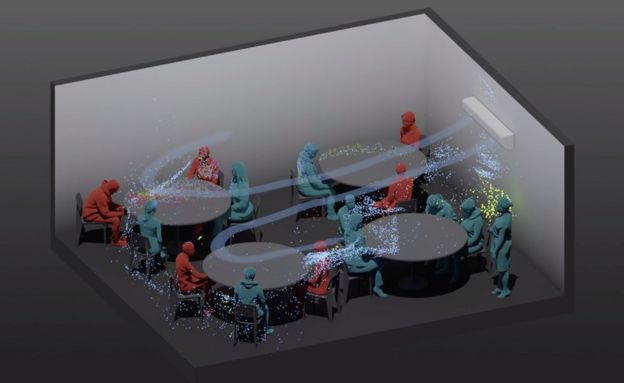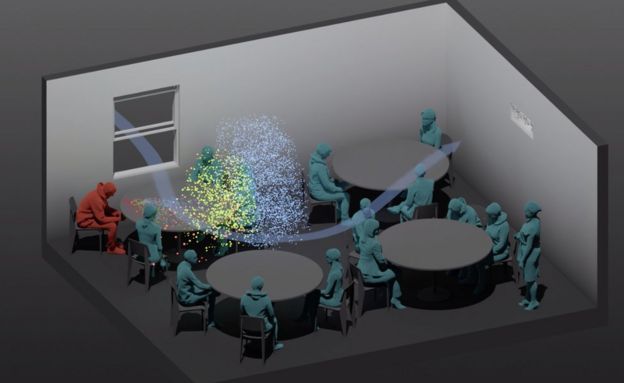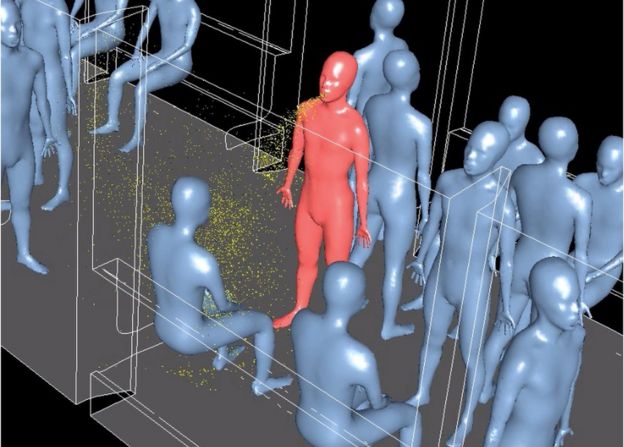

As lockdowns are eased all over the world, what are the risks of getting infected as people come into closer contact with each other?
It’s a question that scientists have been exploring in a variety of settings including restaurants and offices.
Frustratingly, the evidence for how the virus can be transmitted is often slim and if the answers seem vague it’s because the science is uncertain.
It comes amid pressure from businesses, such as pubs, to be allowed to reopen.
But the influence is also coming from people wondering if the rules are too strict.
The most obvious is distance.
Research that began in the 1930s showed that when someone coughs, most of the droplets they release either evaporate or fall to the ground within about one metre.
That’s why the World Health Organization (WHO) settled on its “one metre” rule for social distancing.
Some governments have opted for a safer limit of 1.5m with the UK and others preferring an even more cautious 2m.
The guidance essentially means that the further you’re apart, the safer you ought to be but it’s not distance alone that matters.
The second key factor is timing – how long you’re close to someone.

The UK government’s advice is that spending six seconds with an infected person 1m away carries the same risk as spending one minute with them if they’re 2m away.
And where it’s not possible to keep your distance from a colleague, the aim is to limit the time together to 15 minutes.
But as well as timing, there’s another important issue: ventilation.
Being outside carries the least risk because any virus released by someone infected will be diluted in the breeze.
That doesn’t mean the possibility of transmission is zero.
Even out of doors, the UK’s official advice is to stay 2m apart and, if you’re closer, try not to talk face-to-face.
But inside, where there isn’t much fresh air and where people might be close together for longer, the chances of becoming infected are obviously greater.
A fascinating insight comes from a study in the Chinese city of Guangzhou which tracked how a cluster of infections occurred.
Sitting at tables that were one metre apart, people were having a meal last January.
One of the diners was infected with coronavirus but hadn’t realised because they had no symptoms.
But in the following days, another nine people who’d been in the restaurant at the time came down with Covid-19 – including five who’d been sitting at other tables several metres away.
Scientists investigating the infections reached a conclusion about the most likely route of transmission: that droplets containing the virus – released by the infected person – were circulated by air conditioning.
“The key factor for infection was the direction of the airflow,” their study says, blaming two air conditioning units mounted high on a wall.
This is not proof that the virus can be spread this way but the research certainly suggests that it is a plausible route.
And, if confirmed, it would mean that in any room with a similar system of ventilation, even moving tables more than one metre apart would still not guarantee to keep people safe.
To try to understand the risks, a team from the University of Oregon, specialising in the study of microbes in buildings, simulated different types of ventilation in a restaurant.
In one scenario, someone at a corner table coughs without covering their mouth and releases droplets and particles that are projected through the air.
The largest droplets land on their own table – that’s what you’d expect with the WHO’s ‘one metre rule’.

But smaller ones reach beyond the immediate area and are caught in a current of air coming from an air conditioning unit at the other end of the room.
The result is similar to what’s thought to have happened in the restaurant in Guangzhou: tiny droplets and particles are spread to people at other tables.
As with that study, this simulation doesn’t prove that the coronavirus can be transmitted this way or, if it did, that it would make anyone ill.
That depends on whether the virus is still active after being blown across the room and on whether the person receiving it gets a large enough “dose” – but the possibility of infection can’t be ruled out.
According Kevin Van Den Wymelenberg, professor of architecture at the University of Oregon, who led the study, the virus “can be spread further than people might realise”.
The Oregon team simulated another scenario in the same restaurant in which there’s an open window beside the person who coughs and an extractor vent on the opposite wall.
This time the cloud of droplets and particles is not pushed around the room but instead travels in a fairly direct line from window to vent with the result that fewer people are caught in it.
A flow of fresh air to dilute the virus is one of several techniques highlighted by the team as options for managing Covid-19.

“It’s really impossible to completely eliminate risk,” says Prof Van Den Wymelenberg, “but what we showed was a concept for how you could reduce transmission.”
“The good news is that there are things you can do to make safer spaces.”
In addition to bringing in fresh air through windows or mechanical ventilation, other options include improving the standard of filtration and also humidifying the air – moist conditions might encourage droplets to sink to the floor.
Social distancing isn’t likely to be possible – unless the aircraft is half empty – and by definition you’ll be in close contact with others for more than 15 minutes.
So on the basis of those two key factors, the risks may well be higher. The question of ventilation is more debatable.
On the one hand, the air in the cabin is constantly circulated so if someone coughs, even a few rows away, there is a chance the infection will be spread.
On the other hand, modern aircraft filter the cabin air every few minutes and to a high standard.
In factories and offices, social distancing may be harder to follow.
Dr Julian Tang of the University of Leicester has come up an easy “breath test” to check if you’re too close to colleagues.
A consultant virologist at Leicester Royal Infirmary, he’s studied how the air is moved when people speak and concludes that something as simple as a conversation could pass the virus.
“If you can smell your friend’s breath – the garlic or curry or alcohol – you’re inhaling what they’re breathing out.
“And if you’re inhaling enough of that air to smell it, then you’re close enough to inhale any virus that’s also carried in the air with it.”
So far the public advice has focused on what’s called the “droplet” route, someone coughing or sneezing into the eyes, nose or mouth of a person nearby, which has led to the social distancing rules.
It’s also highlighted a second route – surfaces – in which a person who’s infected passes on the virus through contact either directly by shaking hands or by exhaling over surfaces like kitchen worktops.

Others then get the contamination on their hands, directly or by using the same space at work or at home – which is why handwashing is so important.
But there’s a third possibility as well – tiny droplets or particles being carried in the air by speech, for example and that route might be the most important, according to Dr Tang.
“When you’re talking to a colleague you don’t touch them, you don’t spit on them, most of the interaction is by voice and breathing.”
All of which reinforces the idea that there isn’t one way to stay safe: it involves social distancing and keeping any close contacts brief and checking for healthy ventilation. – bbc.com